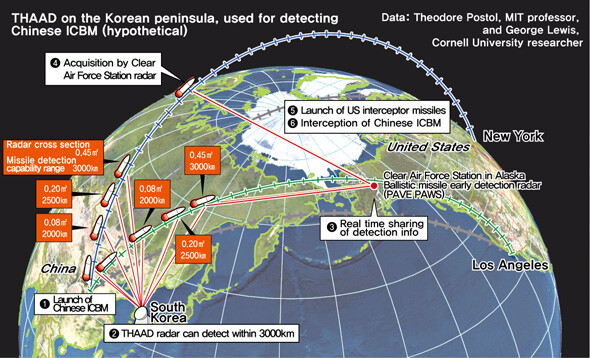hankyoreh
Links to other country sites 다른 나라 사이트 링크
Pentagon document confirms THAAD’s eight-hour conversion ability

The radar for the US weapon system known as THAAD (Terminal High Altitude Air Defense) can be converted from a mode with a short detection range to a mode with a long detection range in eight hours, a Pentagon document confirms.
This demonstrates the hollowness of arguments by proponents of THAAD, who have claimed that if THAAD radar in short detection mode were deployed on the Korean Peninsula, its range would be limited to North Korea and would have little effect on China.
This information turned up in a document titled “Fiscal Year (FY) 2012 Budget Estimates: Missile Defense Agency” that the Hankyoreh accessed from the website of the US Defense Department on June 2. This is the first time that the fact that the modes can be switched in eight hours has been confirmed in a Pentagon document,
which can be viewed at http://comptroller.defense.gov/Portals/45/Documents/defbudget/fy2012/budget_justification/pdfs/03_RDT_and_E/MDA.pdf.
The US government has provoked controversy by strongly hinting at the possibility of deploying THAAD on the Korean Peninsula while refusing to provide detailed information about the system.
The THAAD radar (called AN/TPY-2) is available in two settings: forward-based mode (FBM) and terminal mode (TM). Published in Feb. 2011, the document says, “In a forward-based role, the AN/TPY-2 provides target detection and tracking during the boost phase, reducing uncertainty in target discrimination and reaction time. [. . .] In terminal mode, the AN/TPY-2 provides target acquisition, tracking, and discrimination for fire control of the THAAD Battery.”
“These radars are transportable, adding flexibility to respond to geographical changes in threat,” the document adds.
“Eleven additional AN/TPY-2 Radars are needed [. . .] Each AN/TPY-2 radar can be configured for THAAD [terminal mode] or forward-based mode, and can be switched between modes in eight (8) hours,” the document says.
“The hardware used by the two modes is identical, but their controlling software, operating logic, and communications package are different,” a technology manual for the US army says. In other words, it can be inferred that it takes about eight hours to convert to the second set of software.
This shows that, even if the US deployed the radars in South Korea in terminal mode, they could still be converted to forward-based mode to detect Chinese intercontinental ballistic missiles (ICBMs) in the event that conflict with China intensified.
Some sources indicate that the radar has a detection range of 600-900km in terminal mode and 1,800-2,000km in forward-based mode, but the US army manual only says that the range in forward-based mode is greater than 1,000km.
According to analytical findings that two American missile defense experts recently provided to the Hankyoreh, if the THAAD radar were deployed on the Korean Peninsula, it could detect and track ICBMs launched from China with a maximum range of 3,000km.
These two experts were Theodore Postol, professor at the Massachusetts Institute of Technology (MIT), and George Lewis, senior researcher at Cornell University.
The experts believe that the time required to switch between the two modes could be considerably reduced. “Since military technology develops so rapidly, the time needed for conversion could be reduced even more,” Lewis said.
Postol told the Hankyoreh, “Raytheon executives said last year they can increase the processiong speed of the AN/TPY-2 by five times. It shows how readily critical components of the AN/TPY-2 radars can be upgraded."
"If a delay between switching from TM to FBM modes might be due to a need to change communication modules, modern electronics would surely make it possible to construct a communications module that does both jobs. Hence, claims about the radar only being usable in one or the other mode are essentially technical nonsense," Postol added.

By Park Hyun, Washington correspondent
Please direct questions or comments to [english@hani.co.kr]

Editorial・opinion
![[Editorial] Does Yoon think the Korean public is wrong? [Editorial] Does Yoon think the Korean public is wrong?](https://flexible.img.hani.co.kr/flexible/normal/500/300/imgdb/original/2024/0417/8517133419684774.jpg) [Editorial] Does Yoon think the Korean public is wrong?
[Editorial] Does Yoon think the Korean public is wrong?![[Editorial] As it bolsters its alliance with US, Japan must be accountable for past [Editorial] As it bolsters its alliance with US, Japan must be accountable for past](https://flexible.img.hani.co.kr/flexible/normal/500/300/imgdb/original/2024/0417/6817133413968321.jpg) [Editorial] As it bolsters its alliance with US, Japan must be accountable for past
[Editorial] As it bolsters its alliance with US, Japan must be accountable for past- [Guest essay] Amending the Constitution is Yoon’s key to leaving office in public’s good graces
- [Editorial] 10 years on, lessons of Sewol tragedy must never be forgotten
- [Column] A death blow to Korea’s prosecutor politics
- [Correspondent’s column] The US and the end of Japanese pacifism
- [Guest essay] How Korea turned its trainee doctors into monsters
- [Guest essay] As someone who helped forge Seoul-Moscow ties, their status today troubles me
- [Editorial] Koreans sent a loud and clear message to Yoon
- [Column] In Korea’s midterm elections, it’s time for accountability
Most viewed articles
- 1[Column] The clock is ticking for Korea’s first lady
- 2Samsung barricades office as unionized workers strike for better conditions
- 3[Editorial] When the choice is kids or career, Korea will never overcome birth rate woes
- 4[News analysis] After elections, prosecutorial reform will likely make legislative agenda
- 5S. Korea, Japan reaffirm commitment to strengthening trilateral ties with US
- 6Why Israel isn’t hitting Iran with immediate retaliation
- 7[Guest essay] How Korea turned its trainee doctors into monsters
- 8Japan officially says compensation of Korean forced laborers isn’t its responsibility
- 9[Editorial] Does Yoon think the Korean public is wrong?
- 10[Editorial] 10 years on, lessons of Sewol tragedy must never be forgotten